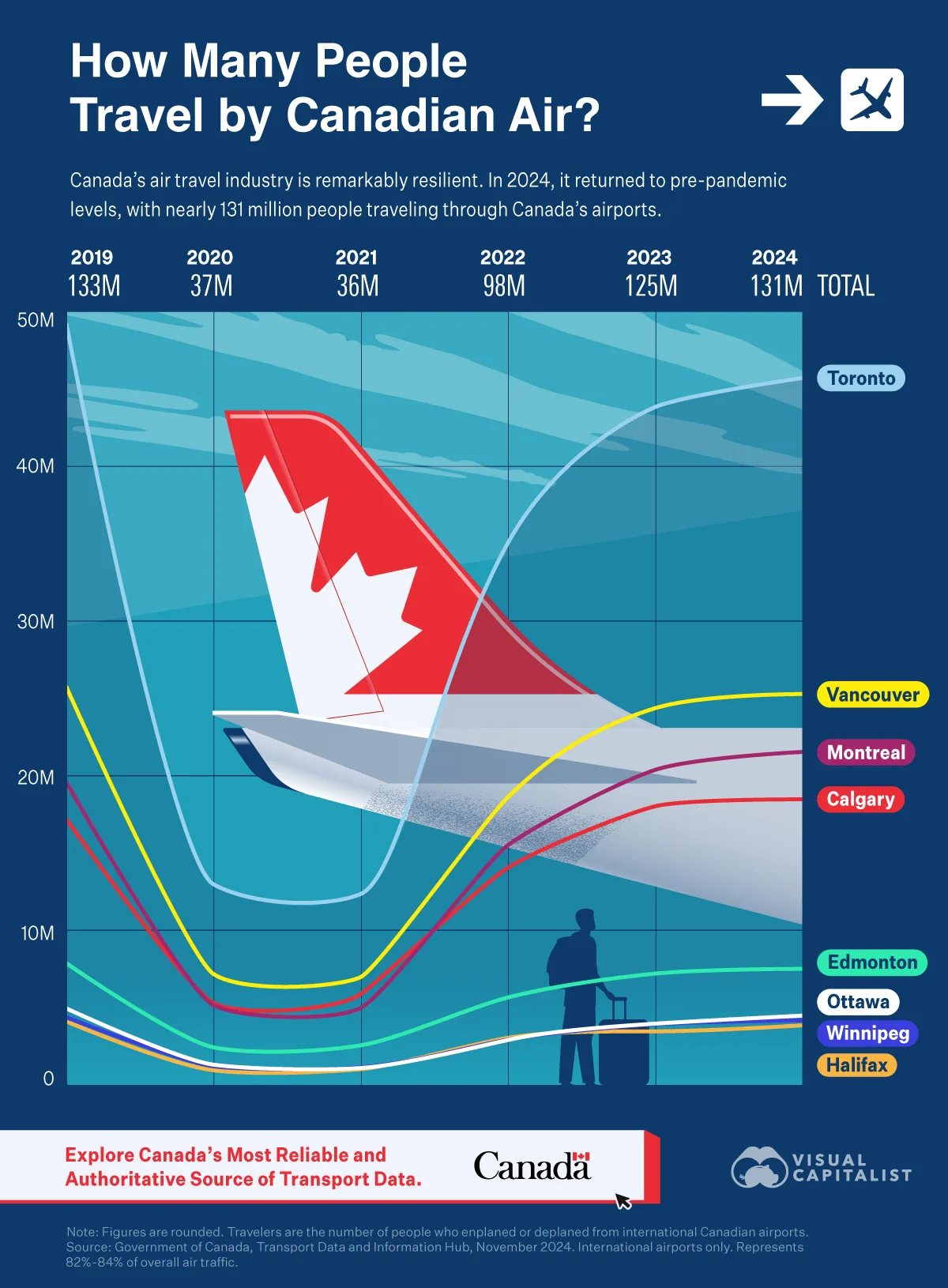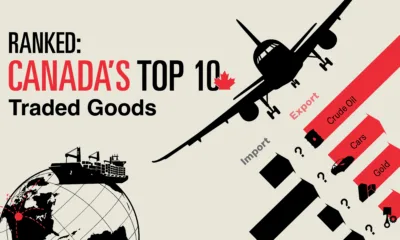
Published
57 minutes ago
on
October 17, 2025
| 332 views
-->
By
Ryan Bellefontaine
Graphics & Design
- Lebon Siu
- Athul Alexander
The following content is sponsored by Transport Canada
How Many People Travel by Canadian Air?
Key Takeaways
- Canadian air passenger volumes reached 131M in 2024, near pre-COVID levels.
- Toronto Pearson remains the country’s primary hub, with 45.7M passengers.
Air travel demand in Canada plummeted as a result of the COVID pandemic. But with the virus in the rearview mirror, has demand for air travel returned to pre-pandemic levels?
This graphic, in partnership with Transport Canada, shows annual passengers moving through major Canadian international airports from 2019 to 2024, using data from the Government of Canada.
Canada’s Air Travel Rebounds
Here is a table that shows annual passengers by major Canadian international airports from 2019 to 2024.
| Airport | 2019 | 2020 | 2021 | 2022 | 2023 | 2024 |
|---|---|---|---|---|---|---|
| Toronto / Lester B. Pearson | 49.2M | 13.0M | 12.4M | 35.0M | 43.8M | 45.7M |
| Vancouver | 25.7M | 7.2M | 7.0M | 18.6M | 24.4M | 25.3M |
| Montreal / Pierre Elliott Trudeau | 19.6M | 5.2M | 5.0M | 15.5M | 20.4M | 21.6M |
| Calgary | 17.2M | 5.3M | 5.9M | 14.1M | 18.0M | 18.5M |
| Edmonton International Airport | 7.9M | 2.5M | 2.6M | 5.7M | 7.2M | 7.5M |
| Ottawa / MacDonald-Cartier | 5.0M | 1.3M | 1.1M | 2.9M | 4.0M | 4.5M |
| Winnipeg James Armstrong Richardson | 4.4M | 1.2M | 1.2M | 3.0M | 4.0M | 4.2M |
| Halifax Stanfield | 4.1M | 1.0M | 1.0M | 3.1M | 3.5M | 3.9M |
| Total | 133.1M | 36.7M | 36.2M | 97.9M | 125.3M | 131.2M |
In total, these airports handled 131 million passengers in 2024 versus 133 million in 2019. The recovery was broad-based across hubs as travel normalized.
Where the Traffic Is Concentrated
Toronto Pearson led the country with 45.7 million passengers in 2024. Vancouver and Montréal followed at 25.3 million and 21.6 million, respectively.
Meanwhile, Calgary reached 18.5 million, while Edmonton, Ottawa, Winnipeg, and Halifax each continued steady gains. Together, these patterns underline how Canadian air hubs have restored connectivity.
These facilities represent roughly 82%–84% of overall air traffic, counting travelers who enplaned or deplaned.
Are you interested in learning more about Canada’s transportation and trade data?
Drawing directly from the most authoritative sources, including the Government of Canada and Statistics Canada, the Transport Data and Information Hub (TDIH) provides information on Canada’s roads, rail networks, air traffic, port activity, trade, and more.

Explore Canada’s Most Reliable and Authoritative Source of Transport Data
Related Topics: #canada #vancouver #airports #montreal #Edmonton #Ottawa #halifax
More from Transport Canada
-

Economy1 week ago
Mapped: Canada’s Busiest Ports
See Canada’s busiest ports by container volume, highlighting Vancouver’s lead and a decade of growth, using government data.
-

Economy3 weeks ago
Ranked: Canada’s Top 10 Traded Goods
This graphic, created in partnership with Transport Canada, explores Canada’s trade and its 10 most traded goods.
Subscribe
Please enable JavaScript in your browser to complete this form.Join 375,000+ email subscribers: *Sign Up